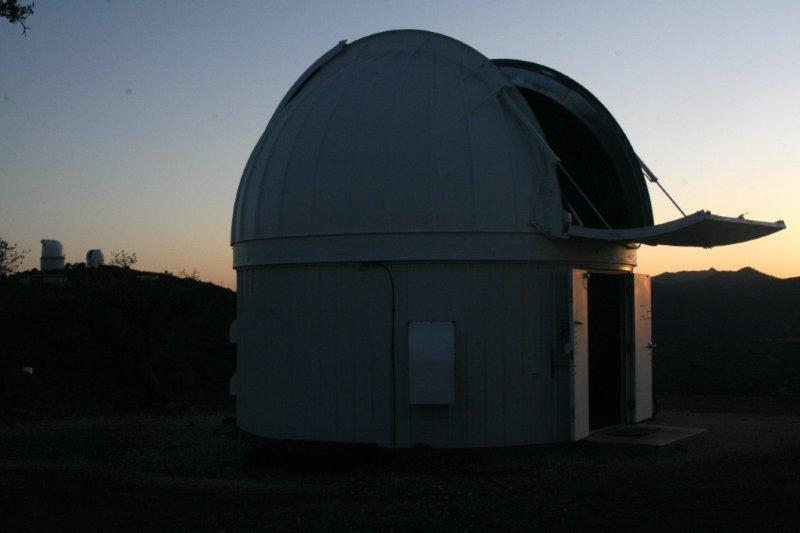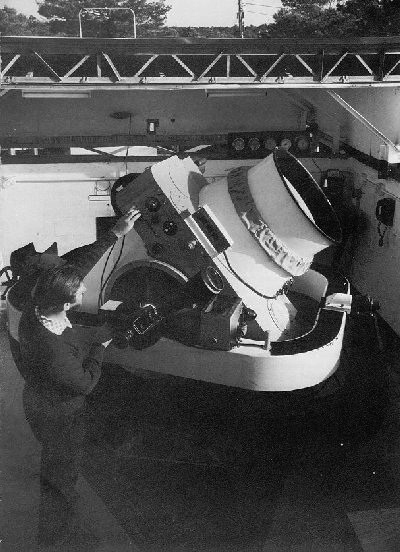|
CTIO
The Cerro Tololo Inter-American Observatory (CTIO) is an astronomical observatory located on Cerro Tololo in the Coquimbo Region of northern Chile, with additional facilities located on Cerro Pachón about to the southeast. It is approximately east of La Serena, where support facilities are located. The site was identified by a team of scientists from Chile and the United States in 1959, and it was selected in 1962. Construction began in 1963 and regular astronomical observations commenced in 1965. Construction of large buildings on Cerro Tololo ended with the completion of the Víctor Blanco Telescope in 1974, but smaller facilities have been built since then. Cerro Pachón is still under development, with two large telescopes (Gemini South and SOAR) inaugurated since 2000, and one in the early stages of construction (the Vera C. Rubin Observatory) The principal telescopes at CTIO are the 4 m Víctor M. Blanco Telescope, named after Puerto Rican astronomer Víctor Man ... [...More Info...] [...Related Items...] OR: [Wikipedia] [Google] [Baidu] |
Víctor Manuel Blanco
Víctor Manuel Blanco (March 10, 1918 – March 8, 2011) was a Puerto Rican astronomer who in 1959 discovered Blanco 1, a galactic cluster.El Escultor de las Galaxias (Spanish) Blanco was the second Director of the in , which had the largest telescope in the Southern Hemisphere at the time. [...More Info...] [...Related Items...] OR: [Wikipedia] [Google] [Baidu] |
Southern Astrophysical Research Telescope
The Southern Astrophysical Research (SOAR) telescope is a modern aperture optical and near-infrared telescope located on Cerro Pachón, Chile at elevation. It was commissioned in 2003, and is operated by a consortium including the countries of Brazil and Chile, Michigan State University, the Cerro Tololo Inter-American Observatory (CTIO) (part of the National Optical Astronomy Observatory, NOAO), and the University of North Carolina at Chapel Hill. Partners have guaranteed shares varying from 10 to 30 percent of the observing time. The telescope uses active optics on its primary and secondary mirrors to attain median image quality 0.7 arcsec at a wavelength of 500 nm. Multiple instruments are available on standby, mounted at unusually high weight-capacity Nasmyth telescope, Nasmyth foci and two lower capacity bent-Cassegrain reflector, Cassegrain foci. Switching is accomplished within a few minutes by rotating the 45° tertiary mirror. The pointing of this mirror is adjuste ... [...More Info...] [...Related Items...] OR: [Wikipedia] [Google] [Baidu] |
Tucson, Arizona
, "(at the) base of the black [hill]" , nicknames = "The Old Pueblo", "Optics Valley", "America's biggest small town" , image_map = , mapsize = 260px , map_caption = Interactive map outlining Tucson , image_map1 = File:Pima County Incorporated and Unincorporated areas Tucson highlighted.svg , mapsize1 = 250px , map_caption1 = Location within Pima County , pushpin_label = Tucson , pushpin_map = USA Arizona#USA , pushpin_map_caption = Location within Arizona##Location within the United States , subdivision_type = Country , subdivision_type1 = U.S. state, State , subdivision_type2 = List of counties in Arizona, County , subdivision_name = United States , subdivision_name1 = Arizona , subdivision_name2 = Pima County, Arizona, Pima , established_title = Founded , established_date ... [...More Info...] [...Related Items...] OR: [Wikipedia] [Google] [Baidu] |
Southern Astrophysical Research Telescope
The Southern Astrophysical Research (SOAR) telescope is a modern aperture optical and near-infrared telescope located on Cerro Pachón, Chile at elevation. It was commissioned in 2003, and is operated by a consortium including the countries of Brazil and Chile, Michigan State University, the Cerro Tololo Inter-American Observatory (CTIO) (part of the National Optical Astronomy Observatory, NOAO), and the University of North Carolina at Chapel Hill. Partners have guaranteed shares varying from 10 to 30 percent of the observing time. The telescope uses active optics on its primary and secondary mirrors to attain median image quality 0.7 arcsec at a wavelength of 500 nm. Multiple instruments are available on standby, mounted at unusually high weight-capacity Nasmyth foci and two lower capacity bent-Cassegrain foci. Switching is accomplished within a few minutes by rotating the 45° tertiary mirror. The pointing of this mirror is adjusted at high speed to prevent image blur f ... [...More Info...] [...Related Items...] OR: [Wikipedia] [Google] [Baidu] |
Portage Lake Observatory
The Portage Lake Observatory (PLO) was an astronomical observatory owned and operated by the University of Michigan (UM). It was located near the village of Dexter, Michigan (USA), about northwest of Ann Arbor. Construction at the site began in 1948, and the facility was closed in 1975. Other observatories that UM has operated include the Detroit Observatory (Ann Arbor, Michigan, 1854), the Angell Hall Observatory (Ann Arbor, Michigan, 1927), the Lamont–Hussey Observatory (South Africa, 1928), the McMath–Hulbert Observatory (Lake Angelus, Michigan, 1930), and the Peach Mountain Observatory (Dexter, Michigan, 1955). Telescopes * A reflecting telescope was built by Tinsley Laboratories in 1969 and installed at PLO the same year. In 1975 it was moved to Kitt Peak National Observatory near Tucson, Arizona, where it is now known as the McGraw-Hill Telescope. * The Heber Doust Curtis Telescope is a Schmidt camera that began operating at PLO in 1950. It was moved to the Cer ... [...More Info...] [...Related Items...] OR: [Wikipedia] [Google] [Baidu] |
Las Cumbres Observatory Global Telescope Network
Las Cumbres Observatory (LCO) is a network of astronomical observatories run by a non-profit private operating foundation directed by the technologist Wayne Rosing. Its offices are in Goleta, California. The telescopes are located at both northern and southern hemisphere sites distributed in longitude around the Earth. For some astronomical objects, the longitudinal spacing of telescopes allows continuous observations over 24 hours or longer. The operating network currently consists of two 2 meter telescopes, nine 1 meter telescopes, and seven 40 cm telescopes, placed at six astronomical observatories. The network operates as a single, integrated, observing facility, using a software scheduler that continuously optimizes the planned observing schedule of each individual telescope. History Rosing incorporated Las Cumbres Observatory in 1993 with the goal of aiding universities, observatories, and individuals in the acquisition and improvement of telescopes, opti ... [...More Info...] [...Related Items...] OR: [Wikipedia] [Google] [Baidu] |
PROMPT (telescope)
PROMPT, an acronym for Panchromatic Robotic Optical Monitoring and Polarimetry Telescopes, is being built by the University of North Carolina at Chapel Hill at Cerro Tololo Inter-American Observatory (CTIO) in Chile. PROMPT's primary objective is rapid and simultaneous multiwavelength observations of gamma-ray burst afterglows, some when they are only tens of seconds old. In addition to measuring redshifts by dropout, and early-time SFDs and extinction curves of sufficiently bright afterglows in unprecedented detail, PROMPT will facilitate quick response observations at larger observatories such as the UNC-led 4.1-m SOAR Telescope. PROMPT will also serve as a platform for undergraduate and high school education throughout the State of North Carolina. PROMPT consists of six 0.41-m Ritchey-Chrétien telescopes by RC Optical Systems on rapidly slewing (9°/sec) Paramount ME mounts by Software Bisque, each under a clamshell dome by Astro Haven. Five of these telescopes use rapid-read ... [...More Info...] [...Related Items...] OR: [Wikipedia] [Google] [Baidu] |
Chile
Chile, officially the Republic of Chile, is a country in the western part of South America. It is the southernmost country in the world, and the closest to Antarctica, occupying a long and narrow strip of land between the Andes to the east and the Pacific Ocean to the west. Chile covers an area of , with a population of 17.5 million as of 2017. It shares land borders with Peru to the north, Bolivia to the north-east, Argentina to the east, and the Drake Passage in the far south. Chile also controls the Pacific islands of Juan Fernández, Isla Salas y Gómez, Desventuradas, and Easter Island in Oceania. It also claims about of Antarctica under the Chilean Antarctic Territory. The country's capital and largest city is Santiago, and its national language is Spanish. Spain conquered and colonized the region in the mid-16th century, replacing Inca rule, but failing to conquer the independent Mapuche who inhabited what is now south-central Chile. In 1818, after ... [...More Info...] [...Related Items...] OR: [Wikipedia] [Google] [Baidu] |
Gemini Observatory
The Gemini Observatory is an astronomical observatory consisting of two 8.1-metre (26.6 ft) telescopes, Gemini North and Gemini South, which are located at two separate sites in Hawaii and Chile, respectively. The twin Gemini telescopes provide almost complete coverage of both the northern and southern skies. They are currently among the largest and most advanced optical/infrared telescopes available to astronomers. ''(See List of largest optical reflecting telescopes)''. The National Science Foundation (NSF) of the United States, the National Research Council of Canada, CONICYT of Chile, MCTI of Brazil, and MCTIP of Argentina own and operate the Gemini Observatory. The NSF is currently (2017) the majority partner, contributing approximately 70% of the funding needed to operate and maintain both telescopes. The operations and maintenance of the observatory is managed by the Association of Universities for Research in Astronomy (AURA), through a cooperative agreement with NSF. ... [...More Info...] [...Related Items...] OR: [Wikipedia] [Google] [Baidu] |
Yale University
Yale University is a Private university, private research university in New Haven, Connecticut. Established in 1701 as the Collegiate School, it is the List of Colonial Colleges, third-oldest institution of higher education in the United States and among the most prestigious in the world. It is a member of the Ivy League. Chartered by the Connecticut Colony, the Collegiate School was established in 1701 by clergy to educate Congregationalism in the United States, Congregational ministers before moving to New Haven in 1716. Originally restricted to theology and sacred languages, the curriculum began to incorporate humanities and sciences by the time of the American Revolution. In the 19th century, the college expanded into graduate and professional instruction, awarding the first Doctor of Philosophy, PhD in the United States in 1861 and organizing as a university in 1887. Yale's faculty and student populations grew after 1890 with rapid expansion of the physical campus and sc ... [...More Info...] [...Related Items...] OR: [Wikipedia] [Google] [Baidu] |
Boller And Chivens
Boller and Chivens was an American manufacturer of high-quality telescopes and spectrographs headquartered in South Pasadena, California. History Founded about 1946 by Harry Berthold Boller (1915-1997) and Clyde Cuthbertson Chivens (1915-2008). the company was acquired in 1965 by Perkin-Elmer. In the 1950s, Boller and Chivens collaborated with Perkin-Elmer to develop and manufacture the large-aperture Baker-Nunn satellite tracking camera for the United States Vanguard space satellite program. In culture A 41-cm (16-inch) Boller and Chivens Cassegrain reflector originally housed at the Harvard-Smithsonian Oak Ridge Observatory in Massachusetts is available for public use at the National Air and Space Museum's Public Observatory Project on the National Mall The National Mall is a landscaped park near the downtown area of Washington, D.C., the capital city of the United States. It contains and borders a number of museums of the Smithsonian Institution, art galleries, cult ... [...More Info...] [...Related Items...] OR: [Wikipedia] [Google] [Baidu] |
Yale University Observatory
The Yale University Observatory, also known as the Leitner Family Observatory and Planetarium, is an astronomical observatory owned and operated by Yale University, and maintained for student use. It is located in Farnham Memorial Gardens near the corner of Edwards and Prospect Streets, New Haven, Connecticut. In the 21st century, the Yale Student Observatory, the Leitner observatory also has public outreaches and supports astronomy for students of the college. However, the Yale Observatory traces its history back to being one of the first formal institutions for astronomical observation in the United States, dating to the 1830s. History In 1828 Sheldon Clark donated 1200 US dollars to Yale to procure a Dollond refracting telescope. Yale's first observatory, the Atheneum, was founded in 1830, situated in a tower. From 1830 it housed Yale's first refractor, a Dollond donated by Sheldon Clark. It was the largest in the United States at the time. With this telescope Olmsted and El ... [...More Info...] [...Related Items...] OR: [Wikipedia] [Google] [Baidu] |




